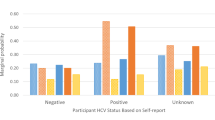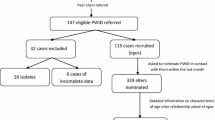Abstract
This analysis aims to identify relationship-level correlates of receptive syringe sharing among women who inject drugs in Philadelphia. Sixty-four women who injected daily were recruited from Prevention Point Philadelphia’s syringe exchange program (9/2/20 − 11/23/20). Interviewer-administered surveys collected (1) individual-level demographics and risk behaviors and (2) relationship-level information about each past-6-month injection partner and injecting practices between the two. We built two separate log-binomial regression models which accounted for clustering of network members within participants to identify relationship-level correlates of using a syringe after a partner. Women reported injecting with a syringe previously used by 21.14% of partners. Women were more likely to use a syringe after sex partners (Adjusted Prevalence Ratio [APR]model_1=2.77) and those who provided injection assistance (APRmodel_1=1.92) or emotional support (APRmodel_2=6.19). Future harm reduction efforts could train women to negotiate safer injection practices with sex partners and those who provide injection assistance and/or emotional support.
Resumen
Este análisis tiene como objetivo identificar los correlatos a nivel de relación del compartimiento de jeringas receptivas en las mujeres que se inyectan drogas en Filadelfia. Sesenta y cuatro mujeres que se inyectaron diariamente fueron reclutadas en el programa de intercambio de jeringas de Prevention Point Philadelphia (9/2/20 − 11/23/20). Las encuestas fueron administradas por un entrevistador y recabaron (1) características demográficas y comportamientos de riesgo a nivel del individuo y (2) información sobre la relación con cada pareja de inyección durante los últimos 6 meses, incluidas las prácticas de inyección entre los dos. Construimos dos modelos de regresión logarítmico-binomial separados que representaban la agrupación de miembros de la red dentro de los participantes para identificar correlatos a nivel de relación del uso de una jeringa después de una pareja. Las mujeres utilizaron una jeringa que había sido utilizada previamente por 21.14% de las parejas de inyección enumeradas. Las mujeres eran más probables en usar una jeringa después de las parejas sexuales (Razón de prevalencia ajustada [RPA]model_1 = 2.77) y de quienes las ayudaron a inyectarse (RPAmodel_1 = 1.92) o les brindaron apoyo emocional (RPAmodel_2 = 6.19). Los esfuerzos futuros de reducción del daño podrían capacitar a las mujeres para negociar prácticas de inyección más seguras con sus parejas sexuales y quienes brindan asistencia para la inyección y/o apoyo emocional.
Similar content being viewed by others
Data Availability
Data are available upon request, pending approval of a data use agreement and certification of training in Human Subjects Research.
Code Availability
Code is available upon request.
References
Sanchez DP, Tookes H, Pastar I, Lev-Tov HA. Wounds and skin and soft tissue infections in people who inject drugs and the utility of syringe service programs in their management. Advances in Wound Care. 2021(ja).
Baltes A, Akhtar W, Birstler J, Olson-Streed H, Eagen K, Seal D, et al. Predictors of skin and soft tissue infections among sample of rural residents who inject drugs. Harm Reduct J. 2020;17(1):1–10.
Noroozi M, Armoon B, Ghisvand H, Noroozi A, Karimy M, Bazrafshan MR, et al. Prevalence and risk factors for injection site skin infections among people who inject drugs (PWID) in Tehran. J Cosmet Dermatol. 2019;18(1):258–62.
Colledge S, Leung J, Larney S, Peacock A, Grebely J, Hickman M, et al. Frequency of injecting among people who inject drugs: A systematic review and meta-analysis. Int J Drug Policy. 2020;76:102619.
The United Nations Office on Drugs and Crime. HIV and AIDS 2020 [Available from: https://www.unodc.org/lpo-brazil/en/hiv-aids/index.html.
Peters PJ, Pontones P, Hoover KW, Patel MR, Galang RR, Shields J, et al. HIV infection linked to injection use of oxymorphone in Indiana, 2014–2015. N Engl J Med. 2016;375(3):229–39.
Oster AM, Lyss SB, McClung RP, Watson M, Panneer N, Hernandez AL, et al. HIV cluster and outbreak detection and response: the science and experience. Am J Prev Med. 2021;61(5):130-S42.
Lyss SB, Buchacz K, McClung RP, Asher A, Oster AM. Responding to Outbreaks of Human Immunodeficiency Virus Among Persons Who Inject Drugs—United States, 2016–2019: Perspectives on Recent Experience and Lessons Learned. J Infect Dis. 2020;222(Supplement_5):239-S49.
Alpren C, Dawson EL, John B, Cranston K, Panneer N, Fukuda HD, et al. Opioid use fueling HIV transmission in an urban setting: an outbreak of HIV infection among people who inject drugs—Massachusetts, 2015–2018. Am J Public Health. 2020;110(1):37–44.
Tumpney M, John B, Panneer N, McClung RP, Campbell EM, Roosevelt K, et al. Human Immunodeficiency Virus (HIV) outbreak investigation among persons who inject drugs in Massachusetts enhanced by HIV sequence data. J Infect Dis. 2020;222(Supplement_5):259-S67.
Golden MR, Lechtenberg R, Glick SN, Dombrowski J, Duchin J, Reuer JR, et al. Outbreak of human immunodeficiency virus infection among heterosexual persons who are living homeless and inject drugs—Seattle, Washington, 2018. Morbidity and Mortality Weekly Report. 2019;68(15):344.
Kim MM, Conyngham SC, Smith C, Higgins D, Nassau T, Terrell C, et al. Understanding the Intersection of Behavioral Risk and Social Determinants of Health and the Impact on an Outbreak of Human Immunodeficiency Virus Among Persons Who Inject Drugs in Philadelphia. J Infect Dis. 2020;222(Suppl 5):250-s8.
McClung R, Panneer N, Atkins A, editors. Large HIV outbreak among people who inject drugs, West Virginia, 2018–2019. Conference on Retroviruses and Opportunistic Infections; 2020.
Oregon Health Authority. HIV infection among people who use drugs. 2019.
Ciccarone D. The rise of illicit fentanyls, stimulants and the fourth wave of the opioid overdose crisis. Curr Opin Psychiatry. 2021;34(4):344–50.
Cai Y, Dai Z, Wen S, Bhandari R. Risk Factors Associated With Infection of Blood-Borne Virus among People Who Used Methamphetamine2020.
Gladden RM, Martinez P, Seth P. Fentanyl law enforcement submissions and increases in synthetic opioid–involved overdose deaths—27 states, 2013–2014. Morb Mortal Wkly Rep. 2016;65(33):837–43.
O’Donnell JK, Gladden RM, Seth P. Trends in deaths involving heroin and synthetic opioids excluding methadone, and law enforcement drug product reports, by census region—United States, 2006–2015. MMWR Morbidity and mortality weekly report. 2017;66(34):897.
O’Donnell JK, Halpin J, Mattson CL, Goldberger BA, Gladden RM. Deaths involving fentanyl, fentanyl analogs, and U-47700–10 states, July–December 2016. MMWR Morbidity and mortality weekly report. 2017;66(43):1197.
Lambdin BH, Bluthenthal RN, Zibbell JE, Wenger L, Simpson K, Kral AH. Associations between perceived illicit fentanyl use and infectious disease risks among people who inject drugs. Int J Drug Policy. 2019;74:299–304.
McCann Pineo M, Schwartz RM. Commentary on the coronavirus pandemic: Anticipating a fourth wave in the opioid epidemic. Psychol Trauma: Theory Res Pract Policy. 2020;12(S1):108.
Jenkins RA. The fourth wave of the US opioid epidemic and its implications for the rural US: a federal perspective. Prev Med. 2021;152(Pt 2):106541.
Drug Enforcement Administration. National drug threat assessment. DEA-DCT-DIR-007-20. Washington, DC: Drug Enforcement Administration; 2019.
Kral AH, Anderson R, Flynn NM, Bluthenthal RN. Injection risk behaviors among clients of syringe exchange programs with different syringe dispensation policies. JAIDS J Acquir Immune Defic Syndr. 2004;37(2):1307–12.
Larney S, Peacock A, Mathers BM, Hickman M, Degenhardt L. A systematic review of injecting-related injury and disease among people who inject drugs. Drug Alcohol Depend. 2017;171:39–49.
Larney S, Peacock A, Leung J, Colledge S, Hickman M, Vickerman P, et al. Global, regional, and country-level coverage of interventions to prevent and manage HIV and hepatitis C among people who inject drugs: a systematic review. The Lancet Global Health. 2017;5(12):e1208-e20.
Berkman LF, Glass T, Brissette I, Seeman TE. From social integration to health: Durkheim in the new millennium. Soc Sci Med. 2000;51(6):843–57.
Berkman LF, Glass T. Social integration, social networks, social support, and health. Social Epidemiol. 2000;1:137–73.
Neaigus A, Friedman SR, Goldstein M, Ildefonso G, Curtis R, Jose B. Using dyadic data for a network analysis of HIV infection and risk behaviors among injecting drug users. NIDA Res Monogr. 1995;151:20–37.
Sherman SG, Latkin CA, Gielen AC. SOCIAL FACTORS RELATED TO SYRINGE SHARING. AMONG INJECTING PARTNERS: A FOCUS ON GENDER. Subst Use Misuse. 2001;36(14):2113–36.
Morris MD, Evans J, Montgomery M, Yu M, Briceno A, Page K, et al. Intimate injection partnerships are at elevated risk of high-risk injecting: a multi-level longitudinal study of HCV-serodiscordant injection partnerships in San Francisco, CA. PLoS ONE. 2014;9(10):e109282.
Latkin C, Kuramoto S, Davey-Rothwell M, Tobin K. Social norms, social networks, and HIV risk behavior among injection drug users. AIDS Behav. 2010;14(5):1159–68.
Johnson RA, Gerstein DR III, Cerbone AP, Brown FG. J. HIV risk behaviors in African-American drug injector networks: implications of injection‐partner mixing and partnership characteristics. Addiction (Abingdon England). 2002;97(8):1011–24.
El-Bassel N, Shaw SA, Dasgupta A, Strathdee SA. People who inject drugs in intimate relationships: it takes two to combat HIV. Curr HIV/AIDS Rep. 2014;11(1):45–51.
Latkin CA, Mandell W, Knowlton AR, Doherty MC, Vlahov D, Suh T, et al. Gender differences in injection-related behaviors among injection drug users in Baltimore. Md AIDS Educ prevention: official publication Int Soc AIDS Educ. 1998;10(3):257–63.
Gollub EL, Rey D, Obadia Y, Moatti J-P, Group MS. Gender differences in risk behaviors among HIV + persons with an IDU history: The link between partner characteristics and women’s higher drug-sex risks. Sex Transm Dis. 1998;25(9):483–8.
Freeman RC, Rodriguez GM, French JF. A comparison of male and female intravenous drug users’ risk behaviors for HIV infection. Am J Drug Alcohol Abus. 1994;20(2):129–57.
Rhodes T, Rance J, Fraser S, Treloar C. The intimate relationship as a site of social protection: Partnerships between people who inject drugs. Soc Sci Med. 2017;180:125–34.
Philadelphia Department of Public Health. Infectious Diseases Continue to Spread Among People Who Inject Drugs. CHART. 2021;6(2):1–7.
Philadelphia Department of Public Health. HIV Continues to Spread Among People Who Inject Drugs. CHART. 2019;4(7):1–4.
Lineman T. Prevention Point distributed 4,797,776 syringes in Kensington – in 1 Year. Juniata News Available at: https://juniatanewsphillycom/2020/09/18/prevention-point-distributed-4797776-syringes-in-kensington-in-1-year/. September 18, 2020.
Rhodes T, Quirk A. Drug users’ sexual relationships and the social organisation of risk: the sexual relationship as a site of risk management. Soc Sci Med. 1998;46(2):157–69.
Rhodes T. Risk theory in epidemic times: sex, drugs and the social organisation of ‘risk behaviour’. Sociol Health Illn. 1997;19(2):208–27.
Rhodes T, Treloar C. The social production of hepatitis C risk among injecting drug users: a qualitative synthesis. Addiction (Abingdon England). 2008;103(10):1593–603.
Morris MD, Bates A, Andrew E, Hahn J, Page K, Maher L. More than just someone to inject drugs with: Injecting within primary injection partnerships. Drug Alcohol Depend. 2015;156:275–81.
Gyarmathy VA, Li N, Tobin KE, Hoffman IF, Sokolov N, Levchenko J, et al. Injecting equipment sharing in Russian drug injecting dyads. AIDS Behav. 2010;14(1):141–51.
Morris MD, Andrew E, Tan JY, Maher L, Hoff C, Darbes L, et al. Injecting-related trust, cooperation, intimacy, and power as key factors influencing risk perception among drug injecting partnerships. PLoS ONE. 2019;14(5):e0217811.
Funding
This work was supported by grant R21 AI131979 to investigator Abby E. Rudolph from the National Institute of Allergy and Infectious Diseases. Any findings, conclusions, or recommendations expressed in this publication are those of the author(s) and do not necessarily reflect the view of the organizations or agencies that provided support for this project.
Author information
Authors and Affiliations
Contributions
Abby E. Rudolph: Conceptualization; methodology; formal analysis; visualization; writing – original draft preparation; writing – reviewing and editing; funding acquisition; supervision. Susanna Rhodes: Conceptualization; investigation; literature review; writing – original draft preparation; writing – reviewing and editing.
Corresponding author
Ethics declarations
Conflicts of Interest/Competing Interests
None.
Ethics Approval
The study protocol, recruitment materials, and data collection materials were approved by the institutional review board at Temple University.
Consent to Participate
Informed consent was obtained from all individual participants included in the study.
Consent for Publication
The informed consent document included the following statement, “We may publish the results of this research. However, we will keep your name and other identifying information confidential.”
Additional information
Publisher’s Note
Springer Nature remains neutral with regard to jurisdictional claims in published maps and institutional affiliations.
Rights and permissions
Springer Nature or its licensor holds exclusive rights to this article under a publishing agreement with the author(s) or other rightsholder(s); author self-archiving of the accepted manuscript version of this article is solely governed by the terms of such publishing agreement and applicable law.
About this article
Cite this article
Rudolph, A.E., Rhodes, S.E. Network Correlates of Using a Syringe After an Injection Partner Among Women Who Inject Drugs in Philadelphia Pennsylvania. AIDS Behav 27, 957–968 (2023). https://doi.org/10.1007/s10461-022-03832-0
Accepted:
Published:
Issue Date:
DOI: https://doi.org/10.1007/s10461-022-03832-0




